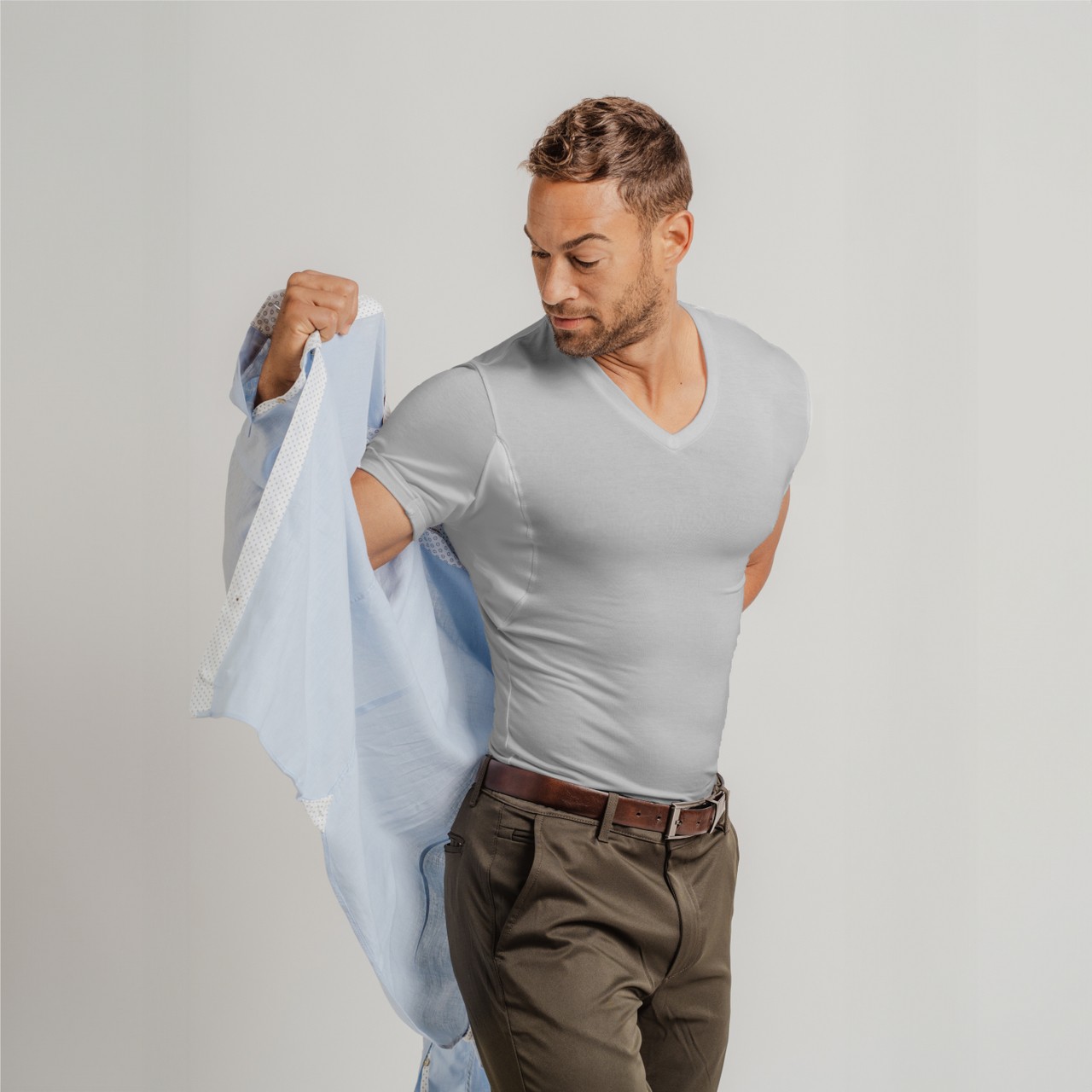10 Best Undershirts for Dress Shirts
Selecting the right undershirt as a base layer for a dress shirt, suit or tuxedo seems like a simple decision. After all, it’s just a shirt… right?
Well, with all of the options, colors, styles and fabrics available on the market, choosing an undershirt for dress shirt is a difficult choice – much less choosing the best undershirt. Pick the right one and you’ll feel comfortable, confident and ready to tackle any occasion; pick the wrong one and you might become an uncomfortable, sweaty mess.
Here are some must-know tips and tricks on how to pick the right undershirt for special occasions as well as 10 of the best undershirts for dress shirts.
Tips to Find the Best Undershirts for Dress Shirts
Here are a few must-know tips to help you find the perfect undershirt to wear under a dress shirt:
- Consider the fit. The undershirt should be snug enough to stay in place and not bunch up under your dress shirt but not so tight that it's uncomfortable or restrictive. Look for undershirts labeled "slim fit" or "tailored fit" for a closer, more streamlined fit.
- Choose the right material. Cotton is a popular choice because it's soft, breathable, and absorbs moisture well. Synthetic materials like polyester and nylon can also be effective, as they wick away moisture and dry quickly. Just be sure to avoid materials that are too thick or heavy (like wool), as they may be noticeable under your dress shirt.
- Be mindful of the neckline. A crew neck undershirt is a classic choice that works well under most dress shirts. However, if you prefer a more streamlined look, a V-neck undershirt can be a good option. Just be sure to choose one that's not too high, as it could be visible under your dress shirt.
- Pay attention to the length. If the undershirt is too long, it may bunch up or peek out from under your dress shirt. On the other hand, if it's too short, it may ride up and cause discomfort.
- Look for moisture-wicking and anti-odor labels. Consider choosing undershirts with these features to help keep you feeling fresh, dry and confident no matter the occasion.
The Best Undershirts for Dress Shirts
Ready to up your undershirt game and complete your professional wardrobe? Here are 10 top-performing undershirts to wear under dress shirts:
- Best Overall: Thompson Tee
- Best Compression: Spanx
- Best Performance: Uniqlo
- Best V-Neck: RibbedTee
- Best Quality: Tommy John
- Best Value: DAVID ARCHY
- Best Tank: Hanes
- Most Affordable: Fruit of the Loom
Thompson Tee - Best Sweat Proof
Thompson Tee’s sweat proof undershirts are made from high-quality, moisture-wicking fabric that helps keep you cool, dry and sweat stain-free all day long. They’re made with patented sweat proof technology, crafted to absorb sweat and block it from seeping onto your outer layers.
Because of their sleek, slim fit, they’re virtually invisible underneath a dress shirt. Plus, they’ll stay tucked underneath dress pants and won’t bunch or ride up as you move about your day. They’re available in crewneck, v-neck and deep v-neck styles, so you’re guaranteed to find one that suits your needs.
Price: $32.99

Thompson Tee Slim Fit V-Neck Undershirt
Spanx - Best Compression
The Sculpt Cotton Crew Neck by Spanx is made from high-quality, stretchy fabric that provides a comfortable and secure fit without feeling uncomfortable or restrictive. It features opaque performance fabric that provides slight firming and reduces bulk under your clothes, making this an ideal choice if you prefer a little extra support. If you’re wearing a slim-fit dress shirt or layers on top, opt for this compression undershirt!
Price: $58
Spanx Sculpt Cotton Crew Neck
Uniqlo - Best Performance
Uniqlo’s AIRism undershirt is designed with performance fabric that’s meant to wick sweat away from your body to keep your skin dry and comfortable. It features anti-microbial and odor-eliminating technologies, which provide added reinforcement against B.O., as well as a classic crewneck and short sleeve design (v-neck also available). It’s also lightweight, breathable and quick-drying, making this a wardrobe essential in warmer months.
Keep in mind that moisture-wicking fabric is not necessarily absorbent. If you struggle with excessive sweating, opt for a more sweat-friendly undershirt that’s designed to wick sweat away from the skin and absorb it.
Price: $14.90
RibbedTee - Best V-Neck
RibbedTee’s EVO TENCEL V-Neck Undershirt is the ultimate v-neck undershirt. It features an extra-low neckline, making this a great option if you want to ensure that your undershirt remains hidden underneath your dress shirt. However, v-necks aren’t a good option only because they’ll hide behind your dress shirt – they’re also great for those who want to appear taller or create the illusion of a longer neck. The EVO TENCEL also has a longer back tail, which helps keep it comfortably tucked.
Price: $34
RibbedTee’s EVO TENCEL V-Neck Undershirt
Tommy John - Best Quality
Tommy John’s Cool Cotton High V-Neck Stay-Tucked Undershirt is the most pricey option on the list – but trust us when we say that it’s a worthwhile investment. This 100% cotton undershirt feels like butter on the skin, and it’s super stretchy and comfortable. And the high-quality material ensures that this undershirt will keep its shape after several wears and washes.
Most notably, this undershirt features a tapered design, helping it stay tucked underneath dress pants while flattering any body type. While this is a great undershirt, it’s also attractive enough to wear alone.
Price: 3-pack for $125
DAVID ARCHY - Best Value
DAVID ARCHY’s Men’s Micromodal V-Neck Undershirt is one of the more affordable options on the list – but, despite the low cost, its quality and comfort are hard to beat. Made from ultra-soft micro modal fabric, this undershirt is gentle on the skin and allows for easy movement. It’s also moisture-wicking and quick-drying, making it a fantastic option for warm environments.
Price: 3-pack for $44.50
Hanes - Best Tank
The Hanes’ Men’s Cotton Tank is a comfortable, classic undershirt option that is ideal if you prefer tanks to short sleeves. Made from 100% cotton, this tank is soft, breathable and ultra-comfortable. It has a classic fit with a ribbed neckline and armholes that provide a comfortable, secure fit, and it’s designed with a tagless neck label for added comfort.
Although this is a great option to wear under dress shirts, keep in mind that a tank top will not protect against sweat or sweat stains.
Price: $19
Fruit of the Loom - Most Affordable
You can’t go wrong with Fruit of the Loom products – and their Eversoft Cotton Stay Tucked Crew T-Shirt is no exception. Made of 100% cotton, this classic undershirt is breathable, comfortable and lightweight. And, as the name suggests, this undershirt will stay tucked underneath dress pants as you move about your day. It also comes in a wide selection of colors – so if you ever find yourself in need of a specific color for a special occasion, this undershirt is a great choice.
Price: 6-pack for $26
Fruit of the Loom Stay Tucked Crew T-Shirt
Why Wear an Undershirt Under a Dress Shirt
Wearing an undershirt under a dress shirt is strongly recommended, and the reason is threefold:
- They protect your dress shirt from deodorant and sweat stains. As you go about your day, your body naturally produces sweat and oils that can rub onto your dress shirt. This can lead to yellowing, discoloration and unpleasant odors over time. An undershirt acts as a barrier between your skin and your outer layer, keeping you and your dress shirt fresh.
- They help smooth out any bumps or lumps under your dress shirt, creating a smoother, more polished appearance. This can be especially useful if you have certain body features that you’d prefer to keep hidden.
- They keep you comfortable and warm under lightweight dress shirts. Even if you have a thick dress shirt, it may not provide enough insulation on its own to keep you warm in chilly temperatures. Wearing an undershirt can help your body maintain heat, keeping you warm and comfortable no matter the occasion.
Read more: Dress Shirts That Don’t Show Sweat
Aren’t Undershirts and T-Shirts The Same Thing?
Both undershirts and t-shirts can be worn underneath outer layers of clothing – but there are some key differences between the two.
One of the main differences between undershirts and t-shirts is the fit. Undershirts are designed to be worn under other clothing (like dress shirts), so they tend to be form-fitting and slim. T-shirts, on the other hand, are looser and have a more relaxed fit.
Another key difference is the fabric. Undershirts are typically made from lightweight, moisture-wicking materials like cotton or a blend of synthetic fabrics. T-shirts are made from a wider range of materials, including cotton, polyester, rayon or blends.
Although it’s tempting to throw on your favorite tee under a dress shirt, don’t do it – especially a graphic tee. It may add unnecessary bulk, and it will likely be visible underneath your dress shirt.
Read more: 8 Sweat-Resistant and Sweat-Absorbing Fabrics
Dress to the Nines With a Thompson Tee
When you’re dressed to impress, the last thing you want is sweat stains showing through your dress shirt.
Thompson Tee’s versatile undershirts are guaranteed to protect your dress shirt from unnecessary stains, absorb sweat, and keep you dry and comfortable no matter the season or occasion. So, whether you’re on the dance floor at a wedding or leading an important meeting at work, trust that you can tackle any situation confidently and sweat stain-free.
Try a Thompson Tee today! Shop men’s styles now.


